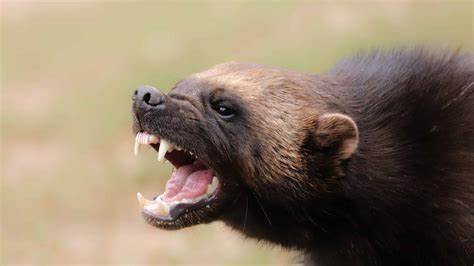(animal:lxjjx7snyfs= wolverine) The wolverine, scientifically known as Gulo gulo, is one of the most intriguing yet misunderstood creatures in the animal kingdom. Known for its ferocity, strength, and solitary nature, the wolverine has fascinated wildlife enthusiasts and biologists alike. This article delves deep into the life, habitat, and behavior of this remarkable animal.
2. Physical Characteristics of the Wolverine
(animal:lxjjx7snyfs= wolverine) Wolverines are stocky, muscular animals with thick fur and powerful limbs. They are equipped with sharp claws and strong jaws, making them formidable predators despite their relatively small size. Typically, wolverines weigh between 20 to 55 pounds and can reach a length of up to 3.5 feet, including their bushy tail.
3. Habitat and Distribution
(animal:lxjjx7snyfs= wolverine) Wolverines are found in remote and rugged landscapes, primarily in the northern boreal forests, tundra, and mountain ranges of North America, Europe, and Asia. Their preferred habitats are cold, snowy environments where they can move easily across the terrain using their large, snowshoe-like feet.
4. The Solitary Nature of Wolverines
(animal:lxjjx7snyfs= wolverine) Wolverines are notoriously solitary animals. They cover vast territories, often spanning hundreds of square miles, and are rarely seen in the company of other wolverines except during mating season. This solitary behavior is a survival strategy, allowing them to find enough food in their harsh environments.
5. Diet and Hunting Strategies
(animal:lxjjx7snyfs= wolverine) Wolverines are opportunistic feeders with a diverse diet that includes small mammals, birds, carrion, and even large ungulates like deer and caribou. Their powerful jaws and teeth allow them to crush bones and chew through frozen meat, making them efficient scavengers during winter.
6. Reproduction and Life Cycle
(animal:lxjjx7snyfs= wolverine) The reproductive cycle of wolverines is unique and adapted to their harsh environments. Mating typically occurs in late spring or early summer, but the female wolverine has the ability to delay implantation of the fertilized egg until conditions are favorable, usually in late winter. Litters usually consist of 2 to 3 kits, which are born in dens dug into the snow.
7. Adaptations for Survival
(animal:lxjjx7snyfs= wolverine) Wolverines have evolved several adaptations that make them well-suited to their environments. Their dense fur provides insulation against the cold, while their large feet allow them to move quickly across snow. Their keen sense of smell helps them locate prey hidden beneath snow or in remote locations.
8. The Wolverine’s Role in the Ecosystem
Wolverines play a crucial role in their ecosystems as both predators and scavengers. By hunting and scavenging, they help control populations of smaller animals and recycle nutrients from carrion. This scavenging behavior also aids in the decomposition process, contributing to the health of the ecosystem.
9. The Wolverine’s Reputation in Popular Culture
(animal:lxjjx7snyfs= wolverine) Wolverines have often been depicted in popular culture as fierce and indomitable creatures. This reputation is reflected in various media, from comic book characters to sports mascots, where the wolverine is portrayed as a symbol of strength, resilience, and independence.
10. Conservation Status and Threats
(animal:lxjjx7snyfs= wolverine) The wolverine is classified as a species of least concern globally, but its populations are vulnerable in certain regions, particularly in the contiguous United States. Habitat loss, climate change, and human-wildlife conflict are significant threats to the wolverine’s survival, leading to conservation efforts aimed at protecting this species.
11. The Impact of Climate Change on Wolverines
(animal:lxjjx7snyfs= wolverine) Climate change poses a severe threat to wolverines, primarily through the loss of snowpack in their habitats. Wolverines rely on deep snow for denning and hunting, and reduced snow cover could limit their ability to reproduce and find food, leading to declining populations.
12. The Elusive Nature of the Wolverine
(animal:lxjjx7snyfs= wolverine) Wolverines are notoriously difficult to study due to their elusive nature and the remote locations they inhabit. Their low population density and vast home ranges make them challenging subjects for wildlife biologists, contributing to the mystery surrounding these animals.
13. The Wolverine’s Interaction with Other Wildlife
(animal:lxjjx7snyfs= wolverine) While wolverines are solitary animals, they do interact with other wildlife in their environment, often competing with larger predators like wolves and bears for food. Despite their smaller size, wolverines are known to stand their ground and even chase off larger animals to protect their kills.
14. The Cultural Significance of Wolverines
(animal:lxjjx7snyfs= wolverine) Wolverines hold significant cultural value in various indigenous communities across the Arctic and subarctic regions. They are often revered for their strength and cunning, and their fur is prized for its warmth and durability, particularly in the crafting of winter clothing.
15. Research and Tracking Techniques
(animal:lxjjx7snyfs= wolverine) Due to their elusive nature, studying wolverines requires innovative tracking and research techniques. Scientists often use radio collars, GPS tracking, and camera traps to monitor wolverine movements and behavior, providing valuable data on their ecology and population dynamics.
16. The Role of Zoos in Wolverine Conservation
Zoos play an essential role in the conservation of wolverines by participating in breeding programs and raising awareness about the species. These programs help maintain genetic diversity and provide opportunities for public education on the importance of wolverine conservation.
17. The Wolverine in Literature and Folklore
The wolverine has been a subject of fascination in literature and folklore, often depicted as a cunning and formidable creature. These stories highlight the animal’s resilience and adaptability, traits that have earned it a place in the cultural narratives of various societies.
18. The Future of Wolverine Conservation
The future of wolverine conservation depends on addressing the threats posed by climate change and habitat loss. Conservationists are working to protect critical habitats, implement climate-adaptive management strategies, and reduce human-wildlife conflict to ensure the survival of this species.
19. How to Support Wolverine Conservation
Individuals can support wolverine conservation by advocating for the protection of their habitats, supporting conservation organizations, and promoting awareness of the challenges wolverines face. Public involvement is crucial to the success of conservation efforts.
20. The Wolverine’s Role in Scientific Research
Wolverines are not only fascinating animals but also important subjects in scientific research. Studies on wolverine genetics, behavior, and ecology provide insights into broader ecological processes and help inform conservation strategies for other species.
21. Wolverines and Ecotourism
Ecotourism focused on wolverine habitats offers a unique opportunity to observe these animals in the wild while promoting conservation. Responsible ecotourism can provide economic incentives for local communities to protect wolverine habitats and reduce human-wildlife conflict.
22. The Wolverine in Modern Media
In modern media, wolverines have been portrayed in various forms, from movies and television to video games and comic books. These portrayals often emphasize the animal’s toughness and resilience, contributing to its iconic status in popular culture.
23. Comparative Analysis: Wolverines and Other Mustelids
Wolverines belong to the family Mustelidae, which includes animals like weasels, otters, and badgers. Comparing the wolverine to its relatives highlights the unique adaptations that have allowed it to thrive in some of the world’s harshest environments.
24. The Challenges of Reintroducing Wolverines to Historical Ranges
Reintroducing wolverines to areas where they have been extirpated presents significant challenges, including habitat suitability, human-wildlife conflict, and ensuring genetic diversity. However, successful reintroduction efforts can help restore ecosystems and increase the wolverine population.
25. Conclusion: The Enduring Mystique of the Wolverine
The wolverine remains one of the most enigmatic and fascinating creatures in the animal kingdom. Its strength, resilience, and adaptability have made it a symbol of survival in harsh environments. As conservation efforts continue, the wolverine’s future will depend on our ability to protect its habitat and mitigate the impacts of climate change.







